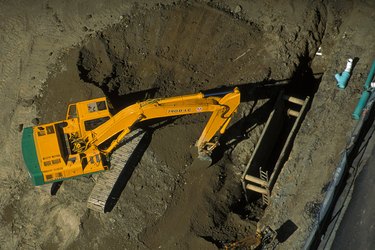Things You'll Need
Architectural plans
Calculator

The volume of soil to be removed when excavating for a basement is actually smaller than the volume of the soil after it has been removed. This is because the untouched soil, measured in bank yards, becomes less compacted when it is disturbed. The less compacted soil occupies more space and is then measured in swelled yards. When discussing the excavations with your local authorities and builders, it is important to specify that your calculations are in bank yards.
Step 1
Establish, from the basement plans, the external depth, width and length of the finished basement. Record these as D, W and L. For example, if the depth is 10 feet, the width is 20 feet and the length is 30 feet, you would have D = 10, W = 20 and L = 30.
Video of the Day
Step 2
Consult with your local authorities and builder to establish how much working space is required around the basement area. Call this distance S. For example, if the builder requires 10 feet of clear space all around the base of the excavation then S = 10.
Step 3
Consult with your local authorities and builder to establish the angle at which the sides of the excavation will slope. The angle is measured from a horizontal line at the base of the excavation. Call this value a. For example, if the sides slope at 45 degrees, then a = 45.
Step 4
Substitute the values into the equation: Volume = ((W + 2S + D/tan a) x D x L) / 27. The result is the volume of undisturbed material to be removed, expressed in cubic yards. For example, if D = 10, W = 20, L = 30, S = 10 and a = 45, the volume to excavate equals 555.56 cubic yards because ((20 + 2x10 + 10/1) x 10 x 30) / 27 = 555.56
Tip
The sides of the excavation must slope down into the excavation to facilitate access and egress and to minimize the risk of the sides collapsing.
Work space and slope angle depend on the condition of the soil, the types of equipment used in the excavation and the building methods. They may also be controlled by local legislation.
Warning
Swelled yards cannot be calculated exactly without data covering the specific soil type and how much it is disturbed during extraction and storage. However, a rough estimate is often used, and assumes that every cubic yard excavated will increase in volume to 1.25 cubic yards.
Video of the Day